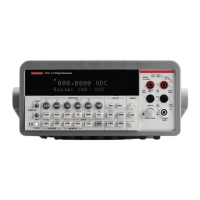:CALCulate3
These commands are used to configure and control the CALC3 limit test.
[:DATA] <n>
:CALCulate3:LIMit [1]:UPPer[:DATA] <n> Specify upper limit1
:CALCulate3:LIMit [1]:LOWEer[:DATA] <n> Specify lower limit
Parameters <n> = -100e6 to 100e6 Specify limit value
DEFault Set specified upper limit to 1
Set specified lower limit to -1
MINimum Set specified limit to -100e6
MAXimum Set specified limit to +100e6
Description This command is used to specify the upper and lower limit for LIMIT1. The
actual limit depends on which measurement function is currently selected.
For example, a limit value of 1 is 1V for the volts functions (DCV or ACV),
1A for the current functions (DCI or ACI), 1
Ω on the ohms functions (2 or
4), and 1 (C, F, or K) for the temperature function (TEMP). A limit value is
not range sensitive. A limit of 1 for DCV is 1V on all measurement ranges.
:STATE <b>
:CALCulate3:LIMit[1]:STATE <b> Control LIMIT1 test
Parameters <b> = 0 or off Disable limit test
1 or on Enable limit test
Query :STATe? Query state (on or off) of limit test
Description This command is used to enable or disable the LIMIT1 test. When enabled,
the test sequence for limits will be performed every time the instrument per-
forms a measurement.
A failed indication (see :FAIL?) for LIMIT1 is cleared when the limit test is
disabled.
:FAIL?
:CALCulate3:LIMit[1]:FAIL? Read LIMIT1 test result
Description This command is used to read the results of the LIMIT1 test:
0 = Limit test failed
1= Limit test passed
The response message (0 or 1) only tells you if a limit test has passed or
failed. It does not tell you which limit (upper or lower) has failed. To deter-
5-24 SCPI Command Reference

